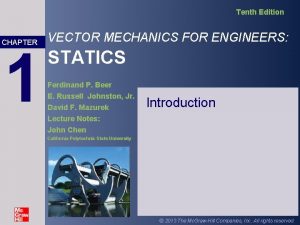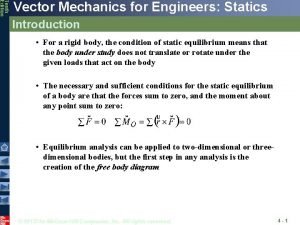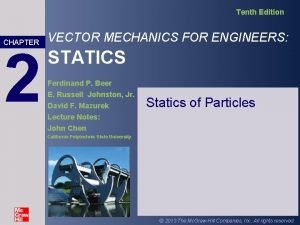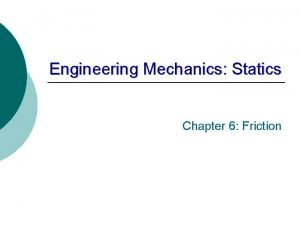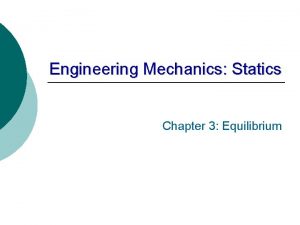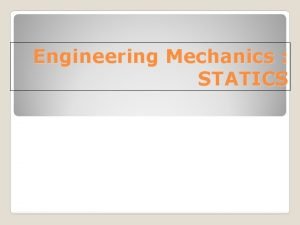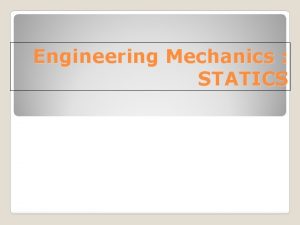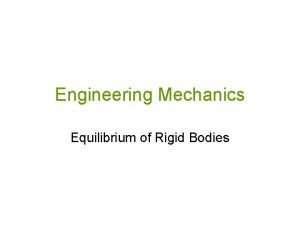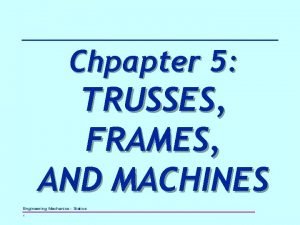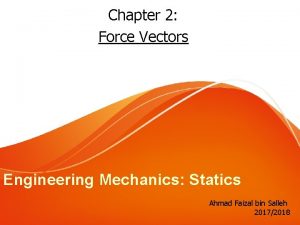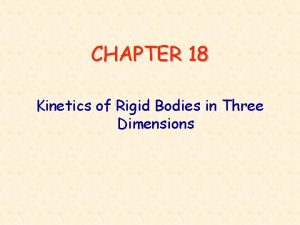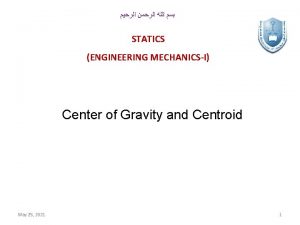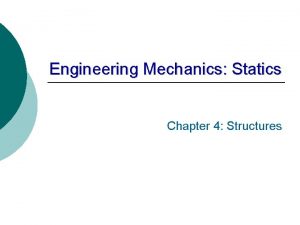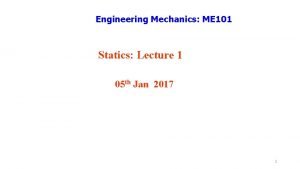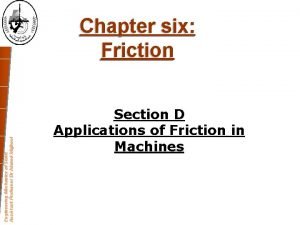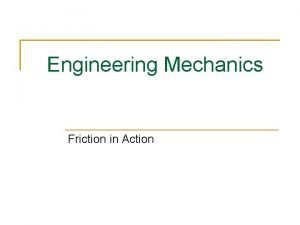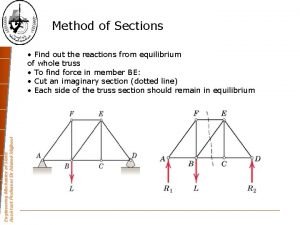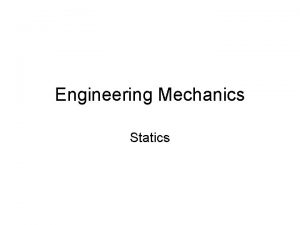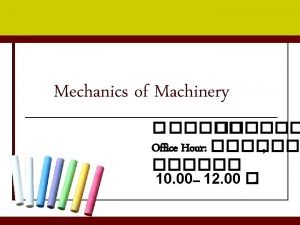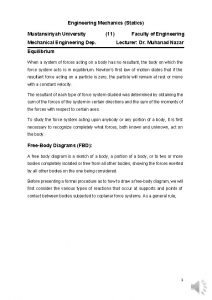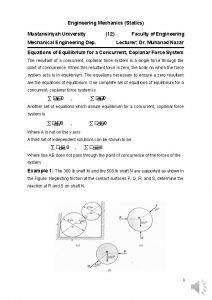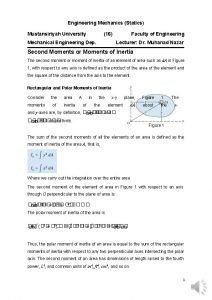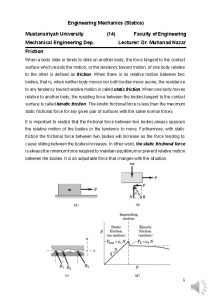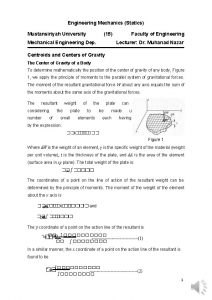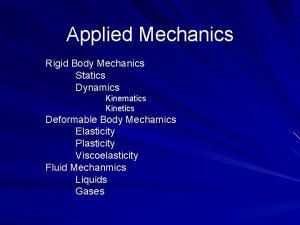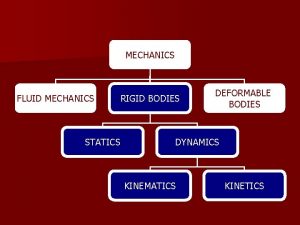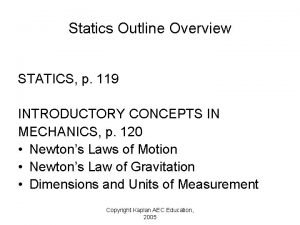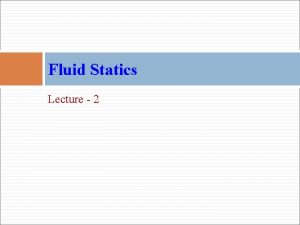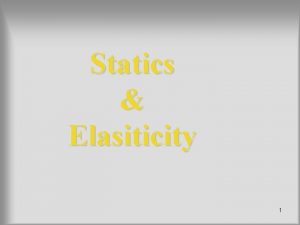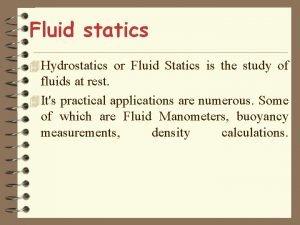Engineering Mechanics Statics in SI Units 12 e





























- Slides: 29

Engineering Mechanics: Statics in SI Units, 12 e 3 Equilibrium of a Particle Copyright © 2010 Pearson Education South Asia Pte Ltd

Chapter Objectives • Concept of the free-body diagram for a particle • Solve particle equilibrium problems using the equations of equilibrium Copyright © 2010 Pearson Education South Asia Pte Ltd

Chapter Outline 1. 2. 3. 4. Condition for the Equilibrium of a Particle The Free-Body Diagram Coplanar Systems Three-Dimensional Force Systems Copyright © 2010 Pearson Education South Asia Pte Ltd

3. 1 Condition for the Equilibrium of a Particle • Particle at equilibrium if - At rest - Moving at constant a constant velocity • Newton’s first law of motion ∑F = 0 where ∑F is the vector sum of all the forces acting on the particle Copyright © 2010 Pearson Education South Asia Pte Ltd

3. 1 Condition for the Equilibrium of a Particle • Newton’s second law of motion ∑F = ma • When the force fulfill Newton's first law of motion, ma = 0 a=0 therefore, the particle is moving in constant velocity or at rest Copyright © 2010 Pearson Education South Asia Pte Ltd

3. 2 The Free-Body Diagram • Best representation of all the unknown forces (∑F) which acts on a body • A sketch showing the particle “free” from the surroundings with all the forces acting on it • Consider two common connections in this subject – – Spring – Cables and Pulleys Copyright © 2010 Pearson Education South Asia Pte Ltd

3. 2 The Free-Body Diagram • Spring – Linear elastic spring: change in length is directly proportional to the force acting on it – spring constant or stiffness k: defines the elasticity of the spring – Magnitude of force when spring is elongated or compressed F = ks Copyright © 2010 Pearson Education South Asia Pte Ltd

3. 2 The Free-Body Diagram • Cables and Pulley – Cables (or cords) are assumed negligible weight and cannot stretch – Tension always acts in the direction of the cable – Tension force must have a constant magnitude for equilibrium – For any angle θ, the cable is subjected to a constant tension T Copyright © 2010 Pearson Education South Asia Pte Ltd

3. 2 The Free-Body Diagram Procedure for Drawing a FBD 1. Draw outlined shape 2. Show all the forces - Active forces: particle in motion - Reactive forces: constraints that prevent motion 3. Identify each forces - Known forces with proper magnitude and direction - Letters used to represent magnitude and directions Copyright © 2010 Pearson Education South Asia Pte Ltd

Example 3. 1 The sphere has a mass of 6 kg and is supported. Draw a free-body diagram of the sphere, the cord CE and the knot at C. Copyright © 2010 Pearson Education South Asia Pte Ltd

Solution FBD at Sphere Two forces acting, weight and the force on cord CE. Weight of 6 kg (9. 81 m/s 2) = 58. 9 N Cord CE Two forces acting: sphere and knot Newton’s 3 rd Law: FCE is equal but opposite FCE and FEC pull the cord in tension For equilibrium, FCE = FEC Copyright © 2010 Pearson Education South Asia Pte Ltd

Solution FBD at Knot 3 forces acting: cord CBA, cord CE and spring CD Important to know that the weight of the sphere does not act directly on the knot but subjected to by the cord CE Copyright © 2010 Pearson Education South Asia Pte Ltd

3. 3 Coplanar Systems • A particle is subjected to coplanar forces in the x-y plane • Resolve into i and j components for equilibrium ∑Fx = 0 ∑Fy = 0 • Scalar equations of equilibrium require that the algebraic sum of the x and y components to equal to zero Copyright © 2010 Pearson Education South Asia Pte Ltd

3. 3 Coplanar Systems • Procedure for Analysis 1. Free-Body Diagram - Establish the x, y axes - Label all the unknown and known forces 2. Equations of Equilibrium - Apply F = ks to find spring force - When negative result force is the reserve - Apply the equations of equilibrium ∑Fx = 0 ∑Fy = 0 Copyright © 2010 Pearson Education South Asia Pte Ltd

Example 3. 4 Determine the required length of the cord AC so that the 8 kg lamp is suspended. The undeformed length of the spring AB is l’AB = 0. 4 m, and the spring has a stiffness of k. AB = 300 N/m. Copyright © 2010 Pearson Education South Asia Pte Ltd

Solution FBD at Point A Three forces acting, force by cable AC, force in spring AB and weight of the lamp. If force on cable AB is known, stretch of the spring is found by F = ks. +→ ∑Fx = 0; TAB – TAC cos 30º = 0 +↑ ∑Fy = 0; TABsin 30º – 78. 5 N = 0 Solving, TAC = 157. 0 k. N TAB = 136. 0 k. N Copyright © 2010 Pearson Education South Asia Pte Ltd

Solution TAB = k. ABs. AB; 136. 0 N = 300 N/m(s. AB) s. AB = 0. 453 N For stretched length, l. AB = l’AB+ s. AB l. AB = 0. 4 m + 0. 453 m = 0. 853 m For horizontal distance BC, 2 m = l. ACcos 30° + 0. 853 m l. AC = 1. 32 m Copyright © 2010 Pearson Education South Asia Pte Ltd

3. 4 Three-Dimensional Force Systems • For particle equilibrium ∑F = 0 • Resolving into i, j, k components ∑Fxi + ∑Fyj + ∑Fzk = 0 • Three scalar equations representing algebraic sums of the x, y, z forces ∑Fxi = 0 ∑Fyj = 0 ∑Fzk = 0 Copyright © 2010 Pearson Education South Asia Pte Ltd

3. 4 Three-Dimensional Force Systems • Procedure for Analysis Free-body Diagram - Establish the z, y, z axes - Label all known and unknown force Equations of Equilibrium - Apply ∑Fx = 0, ∑Fy = 0 and ∑Fz = 0 - Substitute vectors into ∑F = 0 and set i, j, k components = 0 - Negative results indicate that the sense of the force is opposite to that shown in the FBD. Copyright © 2010 Pearson Education South Asia Pte Ltd

Example 3. 7 Determine the force developed in each cable used to support the 40 k. N crate. Copyright © 2010 Pearson Education South Asia Pte Ltd

Solution FBD at Point A To expose all three unknown forces in the cables. Equations of Equilibrium Expressing each forces in Cartesian vectors, FB = FB(r. B / r. B) = -0. 318 FBi – 0. 424 FBj + 0. 848 FBk FC = FC (r. C / r. C) = -0. 318 FCi – 0. 424 FCj + 0. 848 FCk F D = F Di W = -40 k Copyright © 2010 Pearson Education South Asia Pte Ltd

Solution For equilibrium, ∑F = 0; FB + FC + FD + W = 0 -0. 318 FBi – 0. 424 FBj + 0. 848 FBk - 0. 318 FCi – 0. 424 FCj + 0. 848 FCk + FDi - 40 k = 0 ∑Fx = 0; ∑Fy = 0; ∑Fz = 0; -0. 318 FB - 0. 318 FC + FD = 0 – 0. 424 FB – 0. 424 FC = 0 0. 848 FB + 0. 848 FC - 40 = 0 Solving, FB = FC = 23. 6 k. N FD = 15. 0 k. N Copyright © 2010 Pearson Education South Asia Pte Ltd

QUIZ 1. When a particle is in equilibrium, the sum of forces acting on it equals ___. (Choose the most appropriate answer) A) A constant B) A positive number C) Zero D) A negative number E) An integer 2. For a frictionless pulley and cable, tensions in the cables are related as A) T 1 > T 2 B) T 1 = T 2 C) T 1 < T 2 D) T 1 = T 2 sin T 1 Copyright © 2010 Pearson Education South Asia Pte Ltd T 2

QUIZ (A) 100 N (B) 100 N (C) 3. Assuming you know the geometry of the ropes, you cannot determine the forces in the cables in which system above? 4. Why? A) The weight is too heavy. B) The cables are too thin. C) There are more unknowns than equations. D) There are too few cables for a 100 kg weight. Copyright © 2010 Pearson Education South Asia Pte Ltd

QUIZ 5. Select the correct FBD of particle A. 30 A 40 100 kg A) F 1 A B) 100 kg C) 30 40° A F 30° F 2 D) A F 1 30° F 2 40° A 100 kg Copyright © 2010 Pearson Education South Asia Pte Ltd

QUIZ 6. Using this FBD of Point C, the sum of forces in the xdirection ( FX) is ___. Use a sign convention of + . A) F 2 sin 50° – 20 = 0 B) F 2 cos 50° – 20 = 0 C) F 2 sin 50° – F 1 = 0 D) F 2 cos 50° + 20 = 0 Copyright © 2010 Pearson Education South Asia Pte Ltd

QUIZ 7. Particle P is in equilibrium with five (5) forces acting on it in 3 -D space. How many scalar equations of equilibrium can be written for point P? A)2 B) 3 C) 4 D) 5 E) 6 8. In 3 -D, when a particle is in equilibrium, which of the following equations apply? A) ( Fx) i + ( Fy) j + ( Fz) k = 0 B) F = 0 C) Fx = Fy = Fz = 0 D) All of the above. E) None of the above. Copyright © 2010 Pearson Education South Asia Pte Ltd

QUIZ 9. In 3 -D, when you know the direction of a force but not its magnitude, how many unknowns corresponding to that force remain? A) One B) Two C) Three D) Four 10. If a particle has 3 -D forces acting on it and is in static equilibrium, the components of the resultant force ___. A) have to sum to zero, e. g. , -5 i + 3 j + 2 k B) have to equal zero, e. g. , 0 i + 0 j + 0 k C) have to be positive, e. g. , 5 i + 5 j + 5 k D) have to be negative, e. g. , -5 i - 5 j - 5 k Copyright © 2010 Pearson Education South Asia Pte Ltd

QUIZ z 11. Four forces act at point A and point A is in equilibrium. Select the correct F 3 = 10 N force vector P. P F 2 = 10 N A) {-20 i + 10 j – 10 k}lb A y B) {-10 i – 20 j – 10 k} lb C) {+ 20 i – 10 j – 10 k}lb x D) None of the above. 12. In 3 -D, when you don’t know the direction or the magnitude of a force, how many unknowns do you have corresponding to that force? A) One B) Two C) Three D) Four Copyright © 2010 Pearson Education South Asia Pte Ltd
 Engineering mechanics statics in si units
Engineering mechanics statics in si units 2 force systems
2 force systems Statics of rigid bodies
Statics of rigid bodies Line of action of force
Line of action of force Vector mechanics for engineers statics 10th edition
Vector mechanics for engineers statics 10th edition Mechanics
Mechanics Vector mechanics for engineers statics 10th edition
Vector mechanics for engineers statics 10th edition Vector mechanics for engineers 10th edition
Vector mechanics for engineers 10th edition Botox units per ml
Botox units per ml Absorption costing income statement
Absorption costing income statement Friction in engineering mechanics
Friction in engineering mechanics Statics chapter 3
Statics chapter 3 Centroid mechanics
Centroid mechanics Centroid statics examples
Centroid statics examples Equilibrium of rigid bodies in engineering mechanics
Equilibrium of rigid bodies in engineering mechanics Left portion of the roof truss shown cut by section a-a
Left portion of the roof truss shown cut by section a-a Particle equilibrium in 2d and 3d engineering mechanics
Particle equilibrium in 2d and 3d engineering mechanics Statics vectors
Statics vectors Kinetics of rigid body
Kinetics of rigid body Virtual work done
Virtual work done Centroid statics
Centroid statics Statics chapter 4
Statics chapter 4 Me 101 engineering mechanics
Me 101 engineering mechanics Weight center
Weight center Engineering mechanics
Engineering mechanics Belt friction formula
Belt friction formula Internal forces statics
Internal forces statics Force system statics
Force system statics Engineering static
Engineering static Trusses in engineering mechanics
Trusses in engineering mechanics




